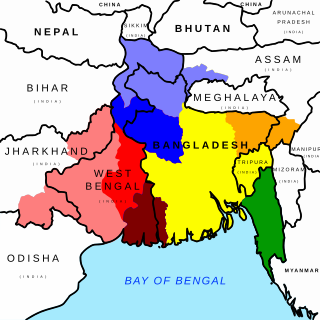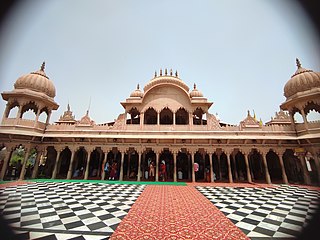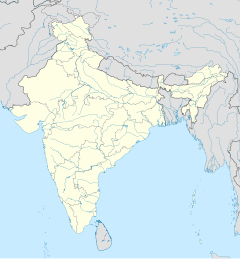
Dhakeshwari National Temple is a Hindu temple in Old Dhaka, Dhaka, Bangladesh. It is state-owned, giving it the distinction of being Bangladesh's 'National Temple'. The name "Dhakeshwari" means "Goddess of Dhaka". Bangladesh is the only country in the World to have a National Hindu Temple. It's one of the holiest Shakta pithas where the gem of Devi sati's crown fell but the gem is lost long ago and the main ancient Vigraha or stone murti is relocated to Kumortuli West Bengal during the partition time by the chief priest due to increased attacks on Hindu temples in Bangladesh.

Dakshineswar Kali Temple or Dakshineswar Kalibari is a Hindu navaratna temple in Dakshineswar, North 24 Parganas, West Bengal, India. Situated on the eastern bank of the Hooghly River, the presiding deity of the temple is Bhavatarini (Kali), a form of Mahadevi or Parashakti Adya Kali, otherwise known as Adishakti Kalika. The temple was built in 1855 by Rani Rashmoni, a Zamindar, philanthropist and a devotee of Kali Maa. The temple is known for its association with Ramakrishna and Ma Sarada Devi, mystics of 19th century Bengal.

Kalighat is a locality of Kolkata (Calcutta), in Kolkata district, West Bengal, India. One of the oldest neighbourhoods in South Kolkata, Kalighat is also densely populated — with a history of cultural intermingling with the various foreign incursions into the area over time.

Ananta Basudeba temple is a Hindu temple of Lord Krishna in the Hangseshwari temple complex in Banshberia, in the Hooghly District in the Indian state of West Bengal. Built by Raja Rameswar Datta in 1679, this temple is noted for the exquisite terra cotta works on its walls. It is built in the traditional eka-ratna style, with curved cornices. The tower on top of the temple is octagonal. The terracota works depict stories from the great Indian epics Ramayana and Mahabharata, as well as from lilas of Krishna.

Kumortuli is a traditional potters' quarter in North Kolkata in West Bengal, India. The city is renowned for its sculpting prowess. It not only manufactures clay idols for various festivals but also regularly exports them.

Shobhabazar is a neighbourhood of North Kolkata, in Kolkata district, in the Indian state of West Bengal.
Sheoraphuli is a neighbourhood in Baidyabati of Hooghly district in the Indian state of West Bengal. It is a part of the area covered by Kolkata Metropolitan Development Authority (KMDA).

The Puthia Temple Complex consists of a cluster of notable old Hindu temples in Puthia Upazila, Rajshahi District, Bangladesh. Located 23 km to the east of Rajshahi city, it has the largest number of historic temples in Bangladesh. The temples were built by Hindu Zamindars Rajas of the Puthia Raj family who were noted philanthropists of Rajshahi. The temples have been built in terracotta in a variety of styles combining the typical Jor-bangla Style architecture with other influences. The Rajbari or Palace of the Raja of Puthia and the Dol Mancha are part of the complex. The temples are laid out around a lake named Shyam Sagar and the complex is surrounded by a moat called Shiv Sagar.

Hinduism is the largest religious tradition in the Indian state of West Bengal with approximately 70.54% of the population identifying themselves as Hindus. The Hindus in West Bengal mostly belong to the Shakta, minority to Vaishnavite and a small community belong to Shaivite and other denominations. The vast majority of Hindus in West Bengal are Bengali Hindus numbering around 55 million and comprising 60.2% of the state population of 91.35 million (2011) but a notable section of non-Bengali Hindus also exist, particularly among Marwaris, Biharis, Odias, Gurkhas, Sindhis, Gujaratis and various tribal communities such as Koch, Santals, Munda, Mech people and particularly Adivadis numbering around 9.4 million comprising rest 10.3% of the state population.
![<span class="mw-page-title-main">Thanthania Kalibari</span> Hindu temple dedicated to Goddess [[Kali]] in Kolkata, India](https://upload.wikimedia.org/wikipedia/commons/thumb/b/bd/Thanthania_Kalibari_-_Kolkata_7421.JPG/320px-Thanthania_Kalibari_-_Kolkata_7421.JPG)
Thanthania Kalibari is a Hindu temple dedicated to the Hindu goddess Kali, first of the ten Mahavidyas in the Hindu tantric tradition and the supreme deity in the Kalikula worship tradition. One of the oldest Kali temples in Kolkata, Maa Kali is worshipped here as "Maa Siddheshwari". Located on Bidhan Sarani in Kolkata, West Bengal, India, hundreds of devotees gather at the temple for worship on the occasion of Kali Puja, Kaushiki Amavasya and Phalaharini Amavasya.

Chhinnamastika Temple is a Hindu temple, dedicated to Goddess Chinnamasta is a Hindu pilgrimage centre located in Rajrappa, in Ramgarh district of Jharkhand, India. The place attracts devotees from all parts of Jharkhand, and also from the neighbouring states of West Bengal and Bihar. The Chhinnamasta temple is popular for its Tantric style of architectural design. Apart from the main temple, there are ten temples of various deities such as the Surya, Hanuman and Shiva.

The Sovabazar Raj family, seated at Sovabazar Palace in the Indian city of Kolkata, were the Zamindars of Shobhabazar. The clan begins with a Maharaja Naba Krishna Deb Bahadur left behind two sons, adopted son Raja Gopimohan Deb (1768) and his own son Raja Raj Krishna Deb. Raja Gopimohan Deb was founder director of Hindu College and founder of famous Dharma Sabha. He offered much precious gold and silver to Maa Kali of Kalighat. A very well known scholar in Hindi, Parsi, and English. His son was Radhakanta Deb, whereas Raja Rajkrishna Deb (1782–1823) had eight sons.

The Sheoraphuli Raj Debuttar Estate or Sheoraphuli Rajbari was part of the Zamindari of the Sheoraphuli Raj, a branch of the erstwhile Patuli Rajbansha which occupies a very high place in the peerage of Bengal. The Calcutta Review for 1845 states the Sheoraphuli family is "descended from one of the most ancient and respected families in Bengal".

Maheswarnath Mandir is a Hindu temple located in the town of Triolet, Mauritius. The presiding deity of the temple is Lord Shiva. The temple was founded in 1888 by Pandit Shri Sajeebunlall Ramsoondur, who came from Calcutta. The temple is famous for its association with the first pilgrimage to Ganga Talao, the sacred lake found in the center of Mauritius. The temple is the biggest and one of the oldest Hindu temples on the island along with the Kovil at Bon Espoir Piton (1830), Sinatambou Kovil at Terre Rouge (1850), Murugan Kovil at Clemencia (1856), the Shivala at Gokoolah (1867), Rameshwarnath Shivala at Terre Rouge (1867) and Jharnath Shivala at l'Aventure (1881). There also old Mandaps and Kalimayes dedicated to Durga and Kali, like the one at Antoinette Phooliyar and a Durga Mandap at Cinema Casse in Triolet itself (1882).
Kiriteswari Temple is situated in Kiritkona village under the Nabagram CD block in the Lalbag subdivision of Murshidabad district in the state of West Bengal. This is one of the Shakti Pithas among the 51 peeths. In September 2023 this area was selected as the best tourism village of India.

Karunamoyee Rani Rashmoni was an Indian Bengali historical drama television series which aired on Bengali Entertainment Channel Zee Bangla and is also available on the digital platform ZEE5. It was premiered on 24 July 2017. The serial was earlier produced by Subrata Roy and then it was produced by Zee Bangla. It completed 1,000 episodes on its third birthday and 1,500 episodes on 26 December 2021. After a successful run of 4+1⁄2 years, Karunamoyee Rani Rashmoni went off-air on 13 February 2022.

Bengal temple architecture also known as Malla dynasty architecture is about temple styles developed and used in Bengal, particularly the chala, ratna and dalan temples.

Shri Radha Rani Temple, is a historical Hindu temple, located in Barsana in Mathura district, Uttar Pradesh, India. The temple is dedicated to the goddess Radha. The main deities of the temple are Radha Krishna who are worshiped together in the form of Shri Laadli Lal, which means the beloved daughter and son of the town.

Ratna Style is a style of Bengal temple architecture, that originated in Bengal from the 15th to 16th centuries, under the Mallabhum kingdom. Originating as a regional style in Hindu temple architecture. It is an extended style of the Chala temple. The special feature of Ratna-style temples is the curved cornice of the chala.

















![<span class="mw-page-title-main">Thanthania Kalibari</span> Hindu temple dedicated to Goddess [[Kali]] in Kolkata, India](https://upload.wikimedia.org/wikipedia/commons/thumb/b/bd/Thanthania_Kalibari_-_Kolkata_7421.JPG/320px-Thanthania_Kalibari_-_Kolkata_7421.JPG)








